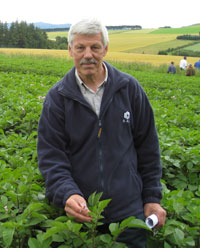Biosecurity takes centre stage at potato event

Biosecurity, desiccation advice and potato virus Y vectors were hot topics at a recent knowledge transfer event in Aberdeenshire. James Andrews reports
Preventing potato diseases from entering the country is a much cheaper alternative that trying to eradicate them once they have taken hold, according to Stuart Wale, head of crop services for Scottish Agricultural College.
Scottish growers were “very lucky” that diseases such as ring rot, dickeya and brown rot were not a problem in their country and the cost of keeping disease out was far lower than the financial burden of managing them once they took hold, he said at the RERAD-funded event in Colpy, Aberdeenshire.
Pests and diseases could be imported in a number of ways, he said. “The most common is through infected or contaminated seed, but other sources include: soil in boxes, packaging or machinery; contact with infected ware potatoes; or waste from processing ware potatoes getting into watercourses.”
Figures from a DEFRA biosecurity review estimated the public cost of an exclusion policy for ring rot in the UK would be £222,000 a year, he said. “This includes the inspection of imports and routine testing of imported seed.”
But the annual cost of dealing with the disease once established was far greater, at an estimated £10.68m, he said.
“There have been three cases of ring rot in the UK so far, allegedly from infected seed being imported. But luckily, through draconian measures, all of the outbreaks were contained.”
Controlling brown rot would also incur high costs. According to a study in The Netherlands, where brown rot levels were relatively high, the average yearly cost of controlling the disease in 2006 was €7.7m (roughly £5.4m in 2007), said Dr Wale.
Scotland had experienced disease scares, such as the dickeya outbreak earlier this year, and although it was dealt with swiftly and efficiently by the government, it should serve as a stark warning to growers, he said.
“It is in everyone’s interest to keep disease out and growers should always question the provenance of seeds they are planting.”
SCRI plant pathology specialist Ian Toth agreed with these sentiments. “We are in a very strong position to keep disease out – if we all stick together and don’t grow foreign seed, we can stop disease coming in.
“The Dutch know they have a big problem and although they are keeping it at bay, all they are doing is firefighting.”
The Safe Haven Scheme was a simple system that allowed safe, disease free seed to filter down through the system, said Dr Wale. “If growers join the scheme and seed flows down through the system, we shouldn’t have a problem with disease.
Joining the scheme costs about £200 a year for each seed grower, including all administration and cleaning costs. Growers would also need factor in the purchase of additional boxes or box cleaning and disinfection.
But the potential losses if a quarantine or regulated non-quarantine pest was detected on-farm would be much greater, he said.
“Growers could lose their entire crop, have to foot the cleaning and disinfection bills, pay for the cost of crop destruction and their reputation could suffer considerably.”
Take care with desiccation
Growers should take care with haulm desiccation to avoid pit rot taking hold, said Dr Wale.
Some growers had experienced problems with pit rot after applying diquat to burn off the crop, so getting the technique right was crucial, he said. “We don’t know if there is a definite link, but it seems to allow more of the blackleg bacteria to get into and infect the lenticels.”
Technique was particularly important if weather was wet in the run up to desiccation as disease pressure would be higher. “If it is dry, any method is acceptable, but if it is wet you need to use the right technique.
“My advice is to spray with 1 litre diquat and wait three days before flailing. The diquat should take some of the greenness out of the crop and make flailing easier. Then spray again roughly four days later with diquat or Spotlight Plus (carfentrazone-ethyl).“
Applying a low diquat dose prior to pulverisation shouldn’t have any effect on the level of pit rot and would make pulverisation easier, he said.

